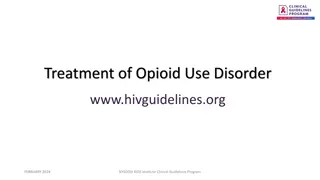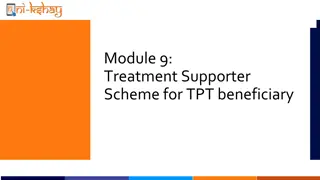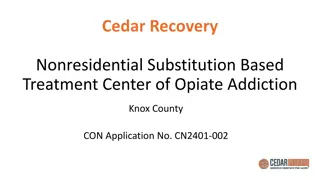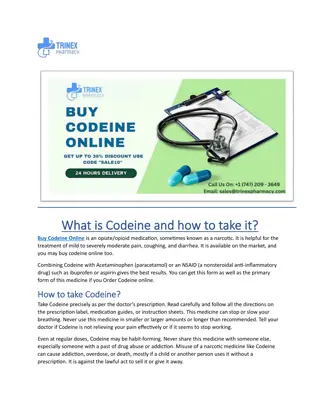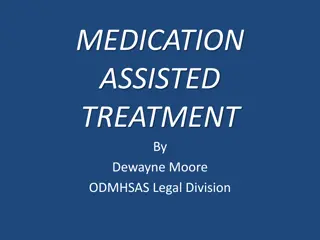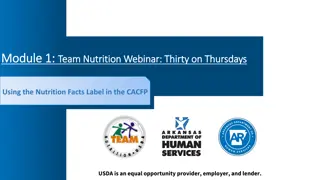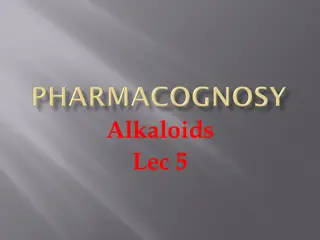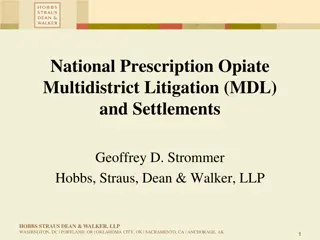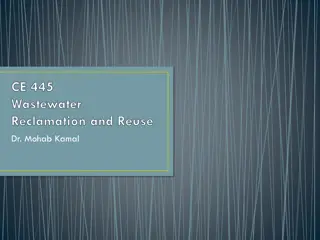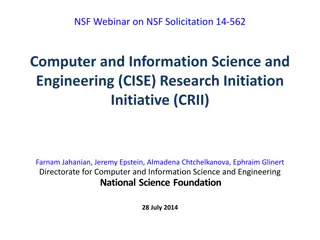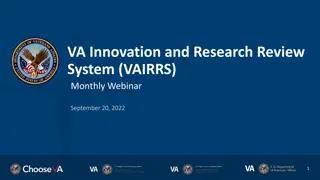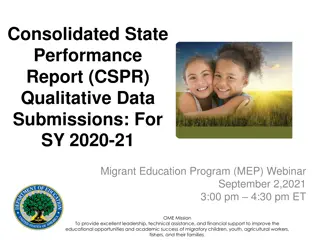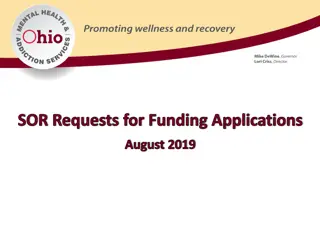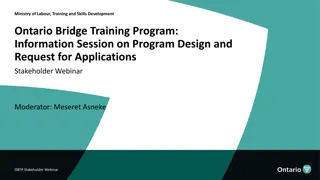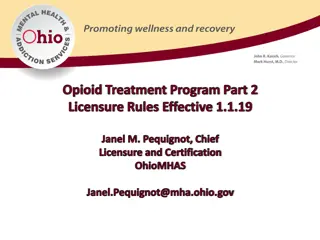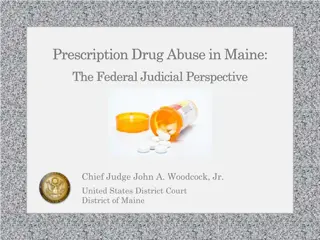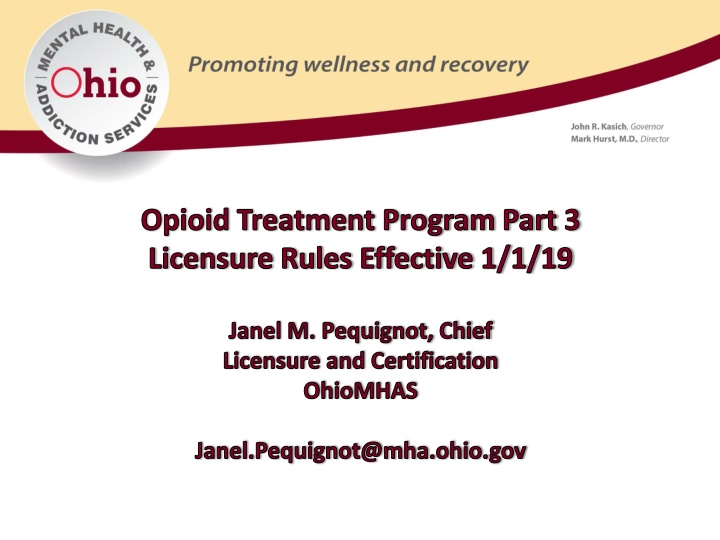
Opioid Treatment Program Part 3 Licensure Rules Update
Stay informed about the latest licensure rules for opioid treatment programs effective from 1/1/19 in Ohio. Learn about the changes, participation in webinars, licensure vs. certification, and big ticket updates to enhance quality and clarity.
Download Presentation

Please find below an Image/Link to download the presentation.
The content on the website is provided AS IS for your information and personal use only. It may not be sold, licensed, or shared on other websites without obtaining consent from the author. If you encounter any issues during the download, it is possible that the publisher has removed the file from their server.
You are allowed to download the files provided on this website for personal or commercial use, subject to the condition that they are used lawfully. All files are the property of their respective owners.
The content on the website is provided AS IS for your information and personal use only. It may not be sold, licensed, or shared on other websites without obtaining consent from the author.
E N D
Presentation Transcript
Opioid Treatment Program Part 3 Licensure Rules Effective 1/1/19 Janel M. Pequignot, Chief Licensure and Certification OhioMHAS Janel.Pequignot@mha.ohio.gov
Website for Recorded Webinars OhioMHAS, Regulation, Licensure and Certification, LC Communications and Training http://mha.ohio.gov/Default.aspx?tabid=743
How to Participate in Todays Webinar 1. Download or print attachments from your control panel. 2. Type questions in the Question box of your control panel and send them. 3. For questions about specific rules, it is helpful to include the rule and paragraph - ex: 02 (B)(2)(i). 4. At end of each section, MHAS will read and answer questions submitted in writing. 5. Time permitting, will allow individuals to ask questions or make comments verbally at end of webinar. You will need to raise your hand on your control panel. You must be connected to audio via phone or microphone.
What This Webinar Will and Will Not Cover Will Cover 1. OAC Chapter 5122-40 Opioid Treatment Program License Regulations Effective Date 1 January 2019 Will NOT Cover 1. Review of OAC Chapters 5122-24 through 5122-29 (Certification standards) 2. Federal or other state agency regulations & processes 3. How to use Methadone or Buprenorphine to treat opiate addiction 4. Clinical practices
Licensure vs. Certification OhioMHAS Licenses the following provider types: 1. Methadone programs 2. Opioid treatment programs (beginning 6/29/19) 3. Private psychiatric inpatient hospitals 4. MH residential facilities OhioMHAS Certifies the following provider types: 1. SUD & MH Outpatient treatment 2. SUD Residential 3. Prevention 4. Driver Intervention Programs
Big Ticket Changes 1. Requires licensure of SAMSHA Certified (non- methadone) Opioid Treatment Programs 2. Updating some portions of rules for clarity, to improve and assure quality, and in response to provider feedback
Big Ticket Changes 1. Requires licensure of SAMSHA Certified (non- methadone) Opioid Treatment Programs 2. Updating some portions of rules for clarity, to improve and assure quality, and in response to provider feedback 3. New rule OAC 5122-40-15 Medication Units
Ohio Revised Code Amended June 29, 2018 5119.391 Methadone Treatment License 5119.392 Methadone Treatment Locations Amended June 29, 2018 and Repealed Effective June 29, 2019 5119.37 Requirements to Operate Opioid Addiction Treatment Programs 5119.371 Location of Opioid Treatment Programs
Who Else Regulates OTPs? 1. Board of Pharmacy (TDDD) 2. SAMSHA 3. DEA 4. CARF/TJC/COA (accreditation)
OAC Rule 5122-40-09 Non-Medication Services
Key Concepts MAT without additional treatment services is not effective Specifies the additional services a provider must make available, and where Identifies those services which may be available by another entity and the process for doing so Requires patients receive med info, informed consent, and orientation, including naloxone kit Specifies patients receive counseling, frequency and duration during first 90 days, and counselor to patient ratio
5122-40-09 (A) (A) Opioid treatment methadone programs shall provide at a minimum, the following services: (1) Prior to July 1, 2017 the assessment, individual counseling, group counseling, medical/somatic, crisis intervention, and case management services pursuant to rule 3793:2-1-08 of the Administrative Code; (1) After July 1, 2017 the The general services, SUD case management services, and crisis intervention services pursuant to Chapter 5122-29 of the Administrative Code. (2) Vocational rehabilitation, education and employment services for patients who either request these services or who have been determined by the program staff to be in need of these services.
5122-40-09 (B) (B) All services shall be provided at the methadone opioid treatment program site. The exception is vocational rehabilitation, education and employment services when the program has entered into a written agreement with another entity to provide these services. The program sponsor shall document that these services are fully and reasonably available to all patients. Services provided through medication units are subject to rule 5122-40-15 of the Administrative Code.
5122-40-09 (C) (C) Upon admission, each patient shall receive the following information both written and verbally: (1) Signs and symptoms of overdose and when, where and how to seek emergency assistance; (2) An explanation of the medication, including: (a) Medication administration; (b) Potential drug interactions; (c) Medical issues related to detoxification from opioid treatment medications; (d) Characteristics of the medications administered or prescribed by the program; (e) Drug safety issues; (f) Dispensing procedures and dosage restrictions; and, (g) Side effects of medications administered or prescribed by the program.
5122-40-09 (C) (continued) (C) Upon admission, each patient shall receive the following information both written and verbally: (3) An explanation of alternative methods that are available for treatment of opioid addiction, whether offered by the program or not, and the potential benefits, risks and costs of each treatment; (4) A formal agreement of informed consent to be signed by the patient and a copy retained by him or her;
5122-40-09 (D) (D) Every person admitted to a methadone opioid treatment program shall receive program orientation within two weeks of admission. The orientation shall be made verbally at the earliest opportunity at which the patient is stable and capable of understanding and retaining the information presented. Orientation shall include the following: (1) An explanation of the patient's rights and right to file a grievance and applicable appeal procedures, in accordance with rule 5122-26-18 of the Administrative Code;
5122-40-09 (D) (continued) (D) Every person admitted to a opioid treatment program shall receive program orientation within two weeks of admission. The orientation shall be made verbally at the earliest opportunity at which the patient is stable and capable of understanding and retaining the information presented. Orientation shall include the following: (2) An explanation of the services and activities provided by the opioid treatment program, including: (a) Expectations and rules; (b) Hours of operation; (c) Access to crisis services; (d) Confidentiality policy; (e) Toxicological screening and random testing policies; (f) Administrative withdrawal criteria, pursuant to rule 5122-40-14 of the Administrative Code; (g) Interventions; and, (h) Incentives, if offered; and, (h) Various discharge criteria.
5122-40-09 (D) (continued) (D) Every person admitted to a methadone program shall receive program orientation within two weeks of admission. The orientation shall be made verbally at the earliest opportunity at which the patient is stable and capable of understanding and retaining the information presented. Orientation shall include the following: (3) An explanation about obtaining reports from the prescription drug monitoring program database; how the reports are used to treat and monitor the patient and the requirement that the reports be maintained in the patient files; (4) An explanation of any and all financial obligations of the patient; all fees charged by the methadone opioid treatment program; and any financial arrangements for services provided by the methadone opioid treatment program; (5) Familiarization with the methadone opioid treatment programs facility and premises;
5122-40-09 (D) (continued) (D) Every person admitted to a methadone program shall receive program orientation within two weeks of admission. The orientation shall be made verbally at the earliest opportunity at which the patient is stable and capable of understanding and retaining the information presented. Orientation shall include the following: (6) Provision of a naloxone kit including the nasal atomizer or other device furnished by the methadone opioid treatment program, or a prescription for such kit. (a) The methadone opioid treatment program shall provide instruction on the kits use including, but not limited to, recognizing the signs and symptoms of overdose and calling 911 in overdose situations. (b) The methadone opioid treatment program shall provide a new naloxone kit or prescription upon expiration or use of the old kit. (c) The methadone opioid treatment program shall be exempt from this requirement for one year if the client refuses the naloxone kit or already has a naloxone kit.
5122-40-09 (E) (E) Documentation that the patient has completed the orientation training and received the written information required in paragraphs (C) and (D) of this rule, shall be completed and signed by the program and the patient and maintained in the patient's chart.
5122-40-09 (F) (continued) (F) Each opioid treatment program shall make available substance use disorder counseling, individual or group, to every patient as is clinically necessary. (1) The ratio of full-time equivalent individual counselors to patients shall be no greater than one to sixty-five; and any currently licensed methadone program with a ratio above that limit shall have until June 1, 2018 to meet this requirement. (2) Counselor to patient ratios shall be individually determined by the specific needs of the patient and allow patients access to their primary counselor if more frequent contact is merited by need or is requested by the patient. (3) The counselor caseload shall: (a) Allow the program to provide adequate psychosocial assessments, treatment planning and individualized counseling; and, (b) Allow for regularly scheduled, documented individual counseling sessions.
5122-40-09 (F) (continued) (F) Each opioid treatment program shall make available substance use disorder counseling, individual or group, to every patient as is clinically necessary. (4) Counseling sessions shall be provided according to generally accepted best practices and shall be offered: (a) At least weekly during the first ninety days of treatment, for at least 50 minutes in duration. (b) Thereafter, counseling duration and frequency should be established by the counselor in collaboration with the patient and documented in the treatment plan, with consideration given to the ability of the patient to participate, recovery status, treatment engagement, and laboratory results. (5) Exceptions to frequency of counselor to patient contact shall be clinically justified and documented in client record.
OAC Rule 5122-40-10 Diversion
Key Concepts Requires diversion control plan that is approved by SOTA Requires pharmacy procedures Identifies who has access to medications throughout its time at the OTP program location, i.e. from delivery through dispensing
5122-40-10 (A) (A) Each methadone opioid treatment program shall, as part of its quality improvement plan, have a diversion control plan that contains specific measures to reduce the possibility of diversion of controlled substances from legitimate treatment use and that assigns specific responsibility for implementing the plan to the medical and administrative staff of the program. (1) The diversion control plan shall be reviewed and approved by the state authority.
5122-40-10 (A) (continued) (A) Each opioid treatment program shall, as part of its quality improvement plan, have a diversion control plan that contains specific measures to reduce the possibility of diversion of controlled substances from legitimate treatment use and that assigns specific responsibility for implementing the plan to the medical and administrative staff of the program. (2) Diversion control plans shall minimize the diversion of opioid agonist and partial opioid agonist medications used for medication assisted treatment to illicit use. The plan shall include: (a) Clinical and administrative continuous monitoring of the potential for and actual diversion including an investigation, tracking and monitoring system of incidents of diversion; and, (b) Proactive planning and procedures for problem identification, correction and prevention.
5122-26-13 Incident Notification and Risk Management This rule requires reporting to MHAS and other entities within 24 hours (exclusive of weekends and holidays) of certain incident categories, including, but not limited to diversion as well as other categories related to medications: Medication Diversion The transfer of any legally prescribed controlled substance from the individual for whom it was prescribed to another person for any illicit use. Selling Drugs on Premises The sale of any medication or illicit drug on the premises of the provider not otherwise part of the provider s normal course of business. Missing/Unaccounted for Medication Prescribed medication under the control of or stored by provider which is missing or unaccounted for, that is not believed to be a result of theft.
5122-26-13 Incident Notification and Risk Management This rule requires reporting to MHAS and other entities within 24 hours (exclusive of weekends and holidays) of certain incident categories, including, but not limited to diversion as well as other categories related to medications: Theft of Medication Allegation of theft of prescribed medication under the control of or stored by the provider. Subcategory (check one) 1. Employee theft 2. Client theft 3. Other/Unknown theft Medication Error Any preventable event while the medication was in the control of the health care professional or client, and which resulted in permanent client harm, hospitalization, or death. Such events may be related to professional practice, health care products, procedures, and systems, including prescribing; order communication, product labeling, packaging, and nomenclature; compounding; dispensing; distribution; administration; education; monitoring; and use. Adverse Drug Reaction Unintended, undesirable or unexpected effect of a prescribed medication(s) that results in permanent client harm, hospitalization, or death.
Performance Improvement 5122-28-03 . (D) Each provider shall develop a written performance improvement plan and document its performance improvement activities. The provider shall include in its performance improvement plan the frequency of data collection and analysis. The provider shall collect and analyze data as required by its accrediting body, if applicable, or for a provider without behavioral health accreditation, at least annually.
5122-40-10 (B) (B) Each methadone opioid treatment program shall have written pharmacy procedures that include: (1) Requirement that accurate records for opioid agonist medication medications used for medication assisted treatment administered and dispensed, or partial opioid agonist medication if administered, be traceable to specific patients and show the date, quantity and batch or lot number of the medication bottle used for preparing individual doses of medication. These records shall be maintained for at least seven years from the last date of administering or dispensing the medication;
5122-40-10 (B) (continued) (B) Each opioid treatment program shall have written pharmacy procedures that include: (2) Requirement that the methadone opioid treatment program meet the security standards for the distribution and storage of controlled substances as required by the United States drug enforcement administration as outlined in 21 CFR 1301.72 to 21 CFR 1301.76 and pursuant to rule 4729-9-11 of the Administrative Code;
5122-40-10 (B) (continued) (B) Each opioid treatment program shall have written pharmacy procedures that include: (3) Requirement that the acceptance of delivery of opioid agonist and partial opioid agonist medications medications used for medication assisted treatment shall only be made by a physician, pharmacist, registered nurse or licensed practical nurse who has proof of completion of a course in medication administration approved by the Ohio board of nursing and does so under the direction of a licensed physician; (a) The person accepting delivery of opioid agonist and partial opioid agonist medications medications used for medication assisted treatment must be an employee of the methadone opioid treatment program.
5122-40-10 (B) (continued) (B) Each opioid treatment program shall have written pharmacy procedures that include: (3) Requirement that the acceptance of delivery of medications used for medication assisted treatment shall only be made by a physician, pharmacist, registered nurse or licensed practical nurse who has proof of completion of a course in medication administration approved by the Ohio board of nursing and does so under the direction of a licensed physician; (b) The methadone opioid treatment program shall maintain a current list of those employees who are authorized to receive delivery of opioid agonist and partial opioid agonist medications medications used for medication assisted treatment. The list shall indicate the name and license number of each person and be signed and dated by the medical director of the methadone opioid treatment program. (4) Requirement that the program shall not employ a physician or other employee who has access to controlled substance, including opioid agonist and partial opioid agonist medications medications used for medication assisted treatment, who has had an application for registration with the U.S. drug enforcement administration (DEA) denied or has had their registration revoked at any time;
5122-40-10 (B) (continued) (B) Each opioid treatment program shall have written pharmacy procedures that include: (5) Requirement that the program notifies the field division of the United States drug enforcement administration for its geographical area of any theft or significant loss of any controlled substance, including opioid agonist medication medications used for medication assisted treatment upon the discovery of the loss or theft; (a) The program shall complete DEA form 106 regarding any loss or theft. (b) The Ohio state board of pharmacy, in accordance with rule 4729-9-15 of the Administrative Code, the Ohio department of mental health and addiction services, and the local law enforcement authorities shall be immediately notified of any loss or theft.
5122-40-10 (B) (continued) (B) Each opioid treatment program shall have written pharmacy procedures that include: (6) Statement that adequate precautions shall be taken to store medications under proper conditions of sanitation, temperature, light, moisture, ventilation, segregation and security; (7) Requirement that patients be required to wait in an area physically separated from the opioid agonist and partial opioid agonist medication assisted treatment storage and dispensing area; and,
5122-40-10 (B) (continued) (B) Each opioid treatment program shall have written pharmacy procedures that include: (8) Requirement that opioid agonist and partial opioid agonist medications used for medication assisted treatment storage and dispensing areas shall: (a) Be located where personnel will not be unduly interrupted when handling drugs; (b) Be maintained in a clean and orderly manner; and, (c) Not be cleaned by a current patient of the program.
OAC Rule 5122-40-11 Toxicology
Key Concepts Requires written procedures for toxicology screenings Toxicology test are scheduled throughout treatment Minimize ability for patient to cheat the test Test for specified drugs Assure accuracy of testing Share all results with patients
5122-40-11 (A) Each methadone opioid treatment program shall have written procedures for toxicology screening that include, at a minimum: (A) Requirement that an initial toxicology screening be performed for each prospective methadone patient as part of the documented physical evaluation completed by a physician prior to admission. The results of all tests must be received within fourteen days following admission.
5122-40-11 (B)(C) Each opioid treatment program shall have written procedures for toxicology screening that include, at a minimum: (B) Requirement that a toxicology screening be performed monthly for each methadone patient. (1) This requirement may be reduced to two toxicology screenings per quarter if the patient has had more than twenty-four consecutive months of negative screens. (2) The failure of a toxicology screening due to illicit drug use shall result in a return to monthly screening. (C) Requirement that programs shall have a standing physician's order for patient toxicology screening.
5122-40-11 (D)(E) Each opioid treatment program shall have written procedures for toxicology screening that include, at a minimum: (D) Requirement that any urine screen sent in for confirmation be performed by a laboratory that is in compliance with all Clinical Laboratory Improvement Amendments per 42 C.F.R. 493. (E) Requirement that toxicology screening be conducted in a manner to minimize falsification and that sample collection procedures include the following: (1) Each specimen collection will be monitored. (2) Each sample shall be labeled to reflect the identification of the person from whom it was obtained and reflect the date the sample was obtained.
5122-40-11 (F) Each opioid treatment program shall have written procedures for toxicology screening that include, at a minimum: (F) Requirements that each toxicology screening include, at a minimum analysis for the following: (1) Opiates, including prescription opioid analgesics as defined in section 3719.01 of the Revised Code, heroin, and fentanyl; (2) Methadone; (3) Amphetamines; (4) Cocaine; (5) Barbiturates; (6) Marijuana; (7) Benzodiazepines, as defined in section 3719.01 of the Revised Code; and, (8) Buprenorphine.
5122-40-11 (G)(H) Each opioid treatment program shall have written procedures for toxicology screening that include, at a minimum: (G) Results of toxicology screening shall be reviewed by the program staff with the patient with documentation of such and a copy of the results placed in the patient's file, in accordance with the requirements of rule 5122-27-04 of the Administrative Code. (H) Provisions for ensuring that presumptive laboratory results are distinguished from confirmatory laboratory results.
5122-40-11 (I) (I) The program shall have a policy for the discontinuation of methadone medication maintenance for individuals who test positive for illicit drugs, which shall include provisions for continuing to provide counseling and other rehabilitation services, or referral to another provider.
OAC Rule 5122-40-12 Disaster Plan
Key Concepts Licensed opioid treatment providers expected to assist in event of temporary or permanent closure of an OTP program Health and Safety Committee engages in disaster planning Maintain supply of medication to be able to guest dose large numbers of patients from other OTPs
5122-40-12 (A) (A) Each methadone opioid treatment program shall maintain an up-to-date disaster plan that addresses emergency situations including fire emergencies, tornadoes, earth quakes, flooding, winter storms, and involuntary temporary or permanent facility closure.
5122-40-12 (B) (B) Methadone Opioid treatment programs shall establish a health and safety committee that initiates planning actions for disaster scenarios. This committee shall: (1) Identify internal resources and areas of need that shall include at minimum: (a) personnel training; (b) equipment needs; (c) evacuation plans; (d) backup systems for payroll, billing records, and patient records; and, (e) communications;
5122-40-12 (B) (continued) (B) Opioid treatment programs shall establish a health and safety committee that initiates planning actions for disaster scenarios. This committee shall: (2) Identify external resources and areas of need that shall include at minimum: (a) suppliers of methadone medication used for treatment of substance use disorder; (b) other opioid treatment programs; and, (c) alternative dosing locations; (3) Develop a communication plan for the disaster scenario to inform patients, the state authority, SAMHSA, the United States drug enforcement administration, and any other parties deemed necessary; and,
5122-40-12 (B) (continued) (B) Opioid treatment programs shall establish a health and safety committee that initiates planning actions for disaster scenarios. This committee shall: (4) Develop disaster documentation procedures for guest patients that shall include at minimum: (a) temporary chart and client identification number; (b) identity verification; and, (c) medication verification.

